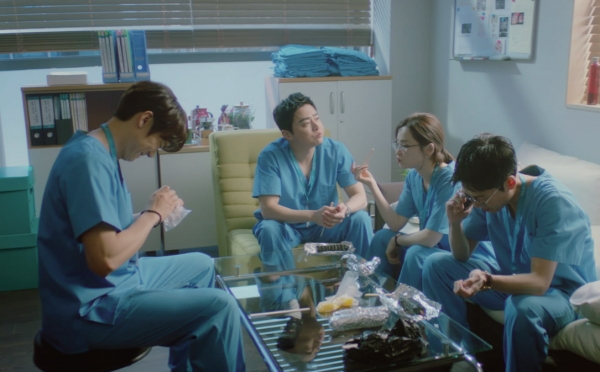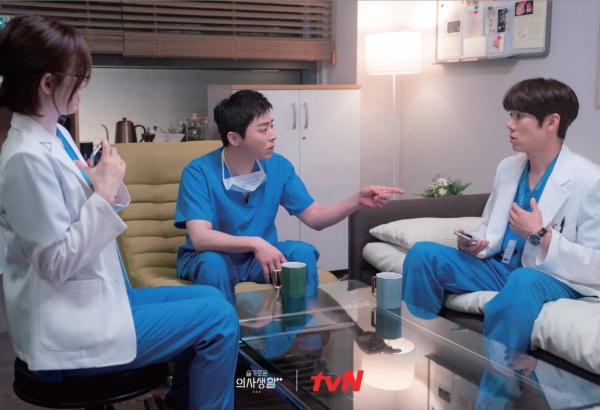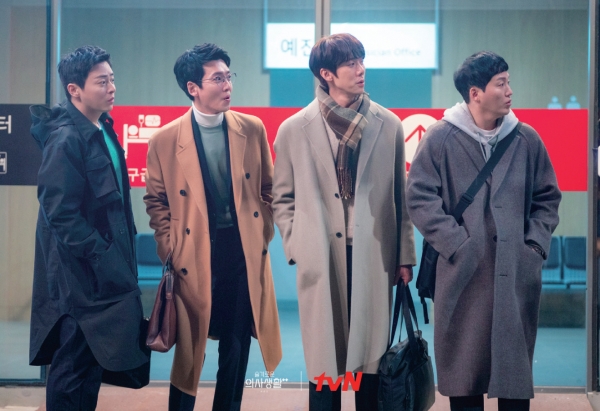
I had been waiting for that day – the day when the second season of 〈Hospital Playlist〉 premiered on TV. Not to lose the flow of the story, I went over the first season several times. My computer was playing the show even in the middle of the night when my eyes were closing. The ringtone on my cell phone is 〈One Summer Drive〉 sung by Cool. It is the song that the heroine of the show was singing when going camping. I set it as my ringtone because I felt I was going out for a camping trip watching the scene. That is how I prepared for watching the second season of 〈Hospital Playlist〉. And finally when the day came, I stopped working to watch it. I don’t easily get into something and have never expected of being such an enthusiast on a show. What is so charming about this show?
〈Hospital Playlist〉 is not a TV show of common style. The story is often interrupted. The scene where Ik-jun sees his patients is followed by Junwan’s dating with his girlfriend. Then the scene catches Jeong-won with his mother, but it changes again into Song-hwa’s surgery. Then comes Seokhyong watching a comedy show on his smart phone. Many of TV shows develop main stories to run to a climax as episodes add up, but this is not the case of 〈Hospital Playlist〉. It takes the format of a situational drama where each episode completes a story in itself. But each episode is packed with many events, refusing to deliver a single main story. According to what we learned at school, stories should be built on the progression of an introduction, development, turn and conclusion. 〈Hospital Playlist〉 doesn’t seem to be following that rule. One might think many different events are simply lined up in each episode. But there does exist a structure of an introduction, development, turn and conclusion in each episode. It is only masked, and that is one of the most charming points of this show.

Most shows tell a main story following main characters, with the stories of supporting characters filling in the rest of the storyline. Even when the story is about a group of people, there are main figures in it. The same is true with situational dramas. However, it does not apply to 〈Hospital Playlist〉. Main characters are the five friends who are from the class of 1999 at a medical school, working as professors at the same general hospital. None of them is missed from the main storyline of each episode. Since each episode of this show runs around 90 minutes, each of the 5 friends can be given around 18 minutes for their own story. Sharing some part of it with the people around them, each main character can have 15 minutes or so to lead his or her own story. The separate story of each character somehow is completed in a given episode. That is, all 5 different stories of the main characters have an introduction, development, turn and conclusion in every episode.

This goes the same with season 2 of the show. Seok-hyong gives a surgery to a woman who is about to give premature birth. Jun-wan places a VAD (Ventricular Assist Device) on a child with a heart problem. Song-hwa gives a brain surgery to a world’s top violinist. Ik-jun sees a patient who doesn’t quit drinking even after having a liver transplant two times. Jeong-won treats a child who is afraid of removing stitches. There are also scenes where the 5 friends go to work or sitaround together to have ramen and strawberries, listening to Jeong-won’s love story. Seok-hyong’s relationship with his ex-wife is added too. Junwan’s long-distance-call with his girlfriendIk-soon cannot be dropped. And the episode ends with Song-hwa hesitating to give a clear answer to a blind-date offer. This way, the show unfolds the 5 friends’ situations before the surgery and appointments, on the surgery, and after the surgery and appointments. Their stories of going to work (Introduction), preparing for a surgery and appointments (Development), surgery and appointments (Turn), and the results (Conclusion) crisscross in each episode. I think such a structure helps to break the possible monotony that comes from the typical progressions, leading the viewers to look forward to what comes next. What is more, it is all right slightly missing part of the story. The viewers can catch up with the missing parts by listening to the songs played by the band of the 5 friends. Their song sums up the message of the episode. In the second episode of season 2, they played 〈In Front of the Post Office in Autumn〉, of which lyric delivers the theme of that episode.
Like the flowers that endured the shower pouring down in the middle of summer
Like the trees that stood strong at a snowstorm last winter,
Could everything under the sky stand alone
Some people call the show a situation comedy, but it deals with too serious topics to be regarded as a sitcom. It provides much of medical information,and the stories are more of a drama than of a comedy. Others call it a medical drama, but it is more focused on the friendship of the 5 friends at a hospital than on the medical information. It might look similar to American medical drama 〈Grey’s Anatomy〉, but the story of the main characters’ friendship that throws laughing moments to the viewers could make it more like a sitcom. (I know I am kind of walking on the Möbius strip.) After all, a ‘fusion medical drama’ sounds suitable for this show. Or would a ‘medical sitcom drama’ be better? 〈Hospital Playlist〉 takes too unique a style to be explained by conventional ways of categorizing dramas.
The show’s producer Shin Won-ho, who used to produce variety shows and writer Lee woo-jung might have only focused on making a funny show. They might have poured out their know-how on keeping people’s attention. Instead of following typical ways of constructing drama stories, they have chosen their own way of delivering what they want to talk about. This reminds me of the ‘YouTube era,’ when one can create one’s own content in one’s own way. 〈Hospital Playlist〉 might be different from traditional dramas, but it could be more palatable to the viewers today, who don’t want to continue to watch when the story is progressed slowly. In that sense, I would say 〈Hospital Playlist〉 tastes like coconut water. It doesn’t have a dramatic strong taste, but carries its unique plain flavor. That is probably what makes coconut water a signature drink. And it wouldn’t be just me who will be drunk by the taste of 〈Hospital Playlist〉.
It is Thursday today, the day <Hospital Playlist> airs on TV. Though I can’t help putting off watching today’s episode due to my work, the fact that I have a new episode to watch exhilarates me. I am perfectly prepared to jump into 〈Hospital Playlist〉, again.
Lee Hyo-jin Screenwriter / Translated by Ok Eurom
* 《Cultura》 2021 August (Vol. 86) *


